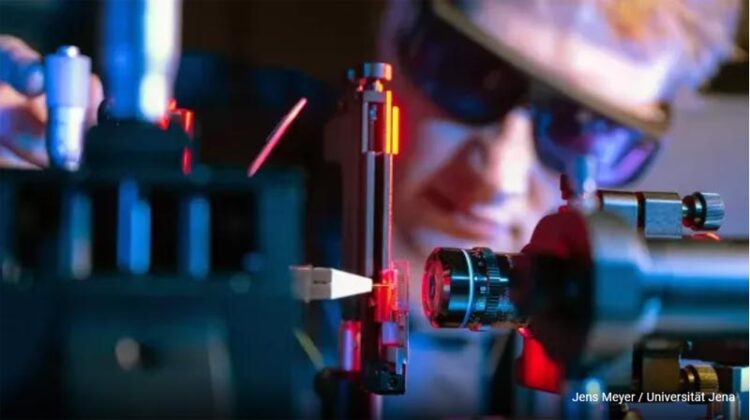Satellites for quantum communications

Tobias Vogl investigates single photon sources in 2D materials in an experimental setup.
(c) Jens Meyer / Universität Jena
Quantum cryptography across large distances.
Through steady advances in the development of quantum computers and their ever-improving performance, it will be possible in the future to crack our current encryption processes. To address this challenge, researchers at the Technical University of Munich (TUM) are participating in an international research consortium to develop encryption methods that will apply physical laws to prevent the interception of messages. To safeguard communications over long distances, the QUICK³ space mission will deploy satellites.
How can it be ensured that data transmitted through the internet can be read only by the intended recipient? At present our data are encrypted with mathematical methods that rely on the idea that the factorization of large numbers is a difficult task. With the increasing power of quantum computers, however, these mathematical codes will probably no longer be secure in the future.
Encryption by means of physical laws
Tobias Vogl, a professor of Quantum Communication Systems Engineering, is working on an encryption process that relies on principles of physics. “Security will be based on the information being encoded into individual light particles and then transmitted. The laws of physics do not permit this information to be extracted or copied. When the information is intercepted, the light particles change their characteristics. Because we can measure these state changes, any attempt to intercept the transmitted data will be recognized immediately, regardless of future advances in technology,” says Tobias Vogl.
The big challenge in so-called quantum cryptography lies in the transmission of data over long distances. In classical communications, information is encoded in many light particles and transmitted through optical fibers. However, the information in a single particle cannot be copied. As a result, the light signal cannot be repeatedly amplified, as with current optical fiber transmissions. This limits the transmission distance for the information to a few hundred kilometers.
To send information to other cities or continents, the structure of the atmosphere will be used. At altitudes higher than around 10 kilometers, the atmosphere is so thin that light is neither scattered nor absorbed. This will make it possible to use satellites in order to extend quantum communications over longer distances.
Satellites for quantum communications
As part of the QUICK³ mission, Tobias Vogl and his team are developing an entire system, including all of the components needed to build a satellite for quantum communications. In a first step, the team tested each of the satellite components. The next step will be to try out the entire system in space. The researchers will investigate whether the technology can withstand outer space conditions and how the individual system components interact. The satellite launch is scheduled for 2025. To create an overarching network for quantum communications, however, hundreds or perhaps thousands of satellites will be needed.
Hybrid network for encryption
The concept does not necessarily require all information to be transmitted using this method, which is highly complex and costly. It is conceivable that a hybrid network could be implemented in which data can be encrypted either physically or mathematically. Antonia Wachter-Zeh, a professor of Coding and Cryptography, is working to develop algorithms sufficiently complex that not even quantum computers can solve them. In the future it will still be enough to encrypt most information using mathematical algorithms. Quantum cryptography will be an option only for documents requiring special protection, for example in communications between banks.
More information:
• Tobias Vogl was appointed as a professor of quantum communication system engineering at the School of Computation, Information and Technology in July 2023. His research focuses on optical quantum technologies in crystalline solids. In particular, he investigates fluorescent defects in the 2D material hexagonal boron nitride, which are combined with resonant nanostructures and photonic circuits for use as components for quantum information processing and in quantum networks.
• The QUICK³ mission is an international research project involving researchers from the Friedrich Schiller University Jena, the Humboldt University of Berlin, Technische Universität Berlin, Ferdinand-Braun-Institut für Höchstfrequenztechnik, the Institute for Photonics and Nanotechnologies in Italy and the National University of Singapore
Wissenschaftliche Ansprechpartner:
Prof. Dr. Tobias Vogl
Technical University of Munich
Professorship of Quantum Communication System Engineering
tobias.vogl@tum.de
Originalpublikation:
Najme Ahmadi, Sven Schwertfeger, Philipp Werner, Lukas Wiese, Joseph Lester, Elisa Da Ros, Josefine Krause, Sebastian Ritter, Mostafa Abasifard, Chanaprom Cholsuk, Ria G. Krämer, Simone Atzeni, Mustafa Gündoğan, Subash Sachidananda, Daniel Pardo, Stefan Nolte, Alexander Lohrmann, Alexander Ling, Julian Bartholomäus, Giacomo Corrielli, Markus Krutzik, Tobias Vogl. “QUICK3 – Design of a Satellite-Based Quantum Light Source for Quantum Communication and Extended Physical Theory Tests in Space“. Adv. Quantum Technol. (2024). https://doi.org/10.1002/qute.202300343
Weitere Informationen:
https://www.tum.de/en/news-and-events/all-news/press-releases/details/satellites…
Media Contact
All latest news from the category: Information Technology
Here you can find a summary of innovations in the fields of information and data processing and up-to-date developments on IT equipment and hardware.
This area covers topics such as IT services, IT architectures, IT management and telecommunications.
Newest articles

Innovative 3D printed scaffolds offer new hope for bone healing
Researchers at the Institute for Bioengineering of Catalonia have developed novel 3D printed PLA-CaP scaffolds that promote blood vessel formation, ensuring better healing and regeneration of bone tissue. Bone is…

The surprising role of gut infection in Alzheimer’s disease
ASU- and Banner Alzheimer’s Institute-led study implicates link between a common virus and the disease, which travels from the gut to the brain and may be a target for antiviral…

Molecular gardening: New enzymes discovered for protein modification pruning
How deubiquitinases USP53 and USP54 cleave long polyubiquitin chains and how the former is linked to liver disease in children. Deubiquitinases (DUBs) are enzymes used by cells to trim protein…



